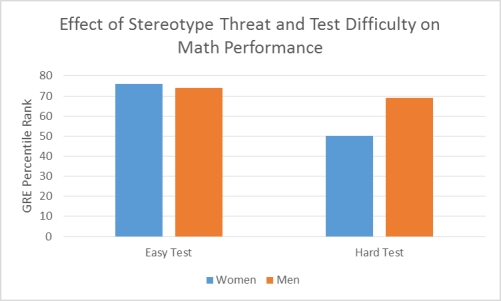Use the following to answer questions
Scenario III
Scenario III is based on fabricated data inspired by the following study:
Spencer, S. J., Steele, C. M. & Quinn, D. M. (1999) . Stereotype threat and women's math performance. Journal of Experimental Social Psychology, 35, 4-28.
Effect of Stereotype Threat on Math Study
The myth that men outperform women in math is widely believed by many individuals. The purpose of the study described in Scenario III was to determine if a sample of women whose math abilities equaled a sample of men would fall victim to this threat. To that end, 28 adult men and 28 adult women were administered an easy math test or a difficult math test. The performance of men and women on both the easy and hard test was quantified. A two-factor ANOVA revealed a significant main effect for test, with participants scoring significantly better on the easy test. The analyses also revealed a main effect for sex, with men performing significantly better than women. The interaction between test difficulty and sex was also statistically significant. Further inspection of the data revealed that although men and women did not differ on the easy math test, women performed significantly less well than men on the difficult math test. Given that the screening criteria for participants including earning a grade of B or better in college calculus, and scoring in at least the 85th percentile on the math subsection of the ACT, the current study indicates that women do succumb to math stereotype threat but only when the math challenge is great. The data are presented in Figure 2.
 Figure 2. Although women and men performed equally on an easy version of the math test, women performed significantly worse than men on the difficult version.
Figure 2. Although women and men performed equally on an easy version of the math test, women performed significantly worse than men on the difficult version.
-(Scenario III) Suppose the researchers described in Scenario III added a third level of difficulty to the math test and added a third variable (time to complete test) . Participants were given 1 hour, 2 hours, or 3 hours to complete the test. This design would now produce how many unique treatment conditions?
A) 3
B) 9
C) 18
D) 27
Correct Answer:
Verified
Q14: Which of the following is an example
Q63: In a 2010 study examining flirting competencies
Q64: A 2007 study examining the scent of
Q65: In a 1986 study examining preferences for
Q66: Use the following to answer questions
Scenario III
Scenario
Q67: A 2002 study involving sex differences in
Q69: In a 2003 study looking at histocompatibility
Q70: Use the following to answer questions
Scenario III
Scenario
Q72: Use the following to answer questions
Scenario III
Scenario
Q111: (Scenario II) The fact that kids with
Unlock this Answer For Free Now!
View this answer and more for free by performing one of the following actions

Scan the QR code to install the App and get 2 free unlocks

Unlock quizzes for free by uploading documents